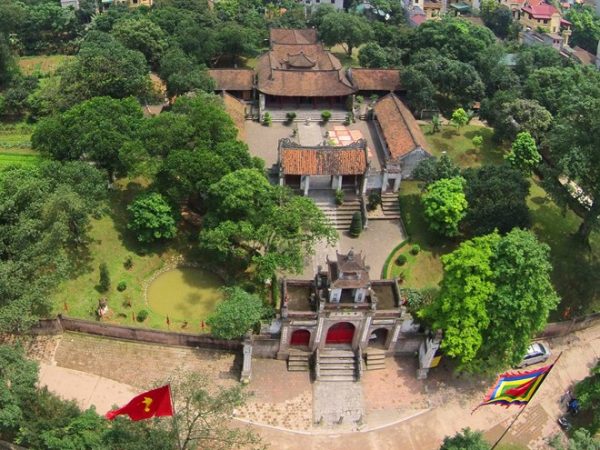According to statistics, Co Loa area has roughly 60 monuments (including 07 national monuments) in the following types: architectural monuments, historical & revolutionary monuments, and archaeological sites.

Co Loa monument (Photo: Internet)
Co Loa people have a diverse spiritual life with various regional traditions such as village twinning, engagement ceremony of Princess My Chau held on Lunar August 13, birthname calling avoiding, chicken – duck and white goose raising avoiding, bride treat and no groom treat and so on. Co Loa Festival is held at Thuong Temple on every Lunar January 6 (supposed to be the day Thuc Phan or An Duong Vuong came to the throne).
Co Loa Monument is also an archaeological site of outstanding values, associated with the archaeological culture of the Vietnamese, such as Son Vi culture, Phung Nguyen culture, Dong Dau culture, Go Mun culture, and particularly Dong Son Culture, with many typical archaeological sites: Dong Vong, Bai Men, Dinh Chien, Dinh Trang, Ma Tre, Thanh Noi, Thanh Ngoai, Thanh Trung, Xuan Kieu, Nhoi area, Thuong temple, Tien Hoi, Duong May, Cau Vuc, etc. In this area, archaeologists discovered thousands of tools, instruments and weapons made of bronze, contributing to clarifying many issues on An Duong Vuong period and the history of this land.
Archaeologists carried out three archaeological excavations in this area in 1970, 2005, 2007 – 2008. The excavation results show that in the history Co Loa was embanked at least 3 times with related traces left in monuments such as the defensive towers, the kitchen monuments, the Dong Son pottery clusters, the brick and tile kilns dating back to the 18th and 19th centuries.
Thuong Temple (An Duong Vuong Temple): was built on a land area of 19,138.6 m2. At the entrance of the temple’s middle door placed a Le Mat dynasty-style stone dragon twin. The temple also has 5 stone steles and 53 objects of huge historical, cultural and scientific values. The temple architecture includes a 3-section hall, 2 side rooms, a timber frame structure, and tile roof, on the top of which are curved sword tips and dog statues. The main trusses are made in form of gong brackets with red paint finish and gold “dragon and cloud” patterns; The central section’s roof is associated with the back section. Inside the temple is An Duong Vuong bronze statue, weighing about 200kg and cast in 1897.

Thuong Temple (Thuc Phan An Duong Vuong Temple). Photo: Internet
From late 2004 to 2007, archaeologists carried out three excavations at Thuong Temple, with 9 pits, on a total area of 311.5 m2. These excavations discovered the copper arrow casting furnace system and many other valuable artifacts.
Co Loa Communal House (Ngu Trieu Di Quy): It has a floor layout in “Dinh” word shape, including the hall and the harem. The hall consists of 5 sections, 2 side rooms, a timber frame structure, a tile roof with four curved sword corners. The roof trusses are structured in the style of “gong brackets” with 6 rows of columns. The harem is connected to the hall through the door below and the roof at the top. The themes of this architecture are of the 18th-century style. In particular, the communal house has maintained 17 typical artifacts of historical, cultural and scientific values.
My Chau shrine (Ba Chua shrine or My Chau temple) is located in an area of 925.4 m2. The architectural layout is arranged in the form of “Nhat-shape front and Dinh-shape back”, including the front houses, the middle hall and the harem.
Co Loa Pagoda (Bao Son Tu) was built in the beginning of the 17th century with the layout of having 2 long corridors connecting the front house and the back house, including the following items: front house, incense offering house, hall, harem, bell tower, grave tower, back gate, To house, Ni house and guest house. Especially, the pagoda has housed 132 artifacts of profoundly historical, cultural and scientific values.
Mach Trang Pagoda (Quang Linh Tu) was built in the Hau Le dynasty on an area of 4,922.4 m2. The direction of the pagoda is the south with the following items: Tam Bao, front house, hall, Mau house, auxiliary house arrays, corridors, etc.
Mach Trang communal house is located on a high land area of 6,198.4 m2, including the front house, hall and harem.
With typical historical, cultural and scientific values, on September 27, 2012, the Prime Minister decided to rank Co Loa historical, architectural and archaeological monument as the special national monument (Decision No. 1419/QD-TTg).
Dat Minh (synthesizing from sources)

